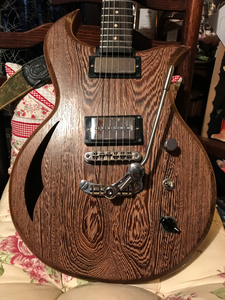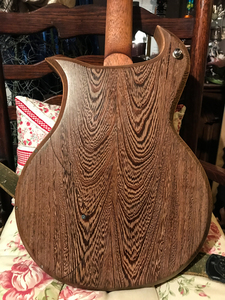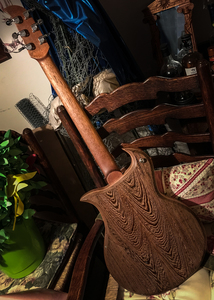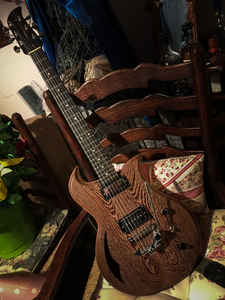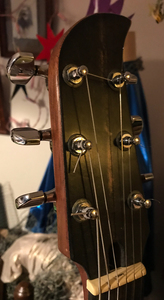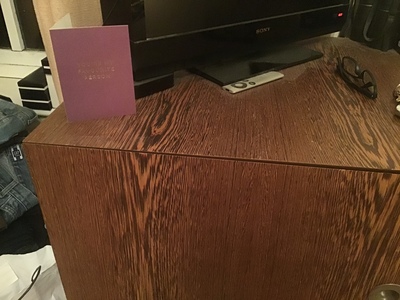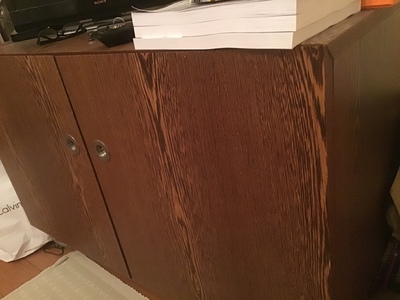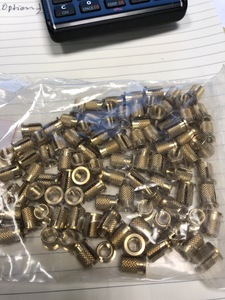Well - I finally got round to this and here are the photos requested by Mark.
I removed the frets and sanded a mm or so off the fingerboard. I re-fretted and quite heavily "rolled" the edges of the 'board (I knew I had plenty of real estate).
I sanded back the oiled/waxed finish on the body and neck and refinished with several coats of renaissance wax applied with a hot cloth.
I fitted a P90 at the bridge in place of the weird hybrid that was there previously.
I removed the coil tap switch, built and fitted a Varitone switch in its place.
I'm much happier with this instrument now.
Next project....
Oooooo - nice cabinet!
Actually all your work looks amazing!
If you look carefully at the back of my build you should discern the sweep of a cover plate along with its 4 screws - kinda influenced by stuff Crimson is doing. Still looking for more appropriate screws. (I posted some photos of the build on another thread on this site.)
thanks for kind comments
H
Hi Herb,
That's a neat job! What about small black hex socketed countersunk machine screws? And you could fit expanding threaded inserts into the body like these if you haven't already done so.
I have a stand opposite Crimson at Makers Central at the NEC in May. I seem to remember that they had a few guitars with them last year but I'm pretty sure that most of their stand was devoted to refurbished hand tools. Or maybe I'm just confused!
More good input - thanks.
Ben at Crimson is a vintage tool nut and runs a shop specialising in those in parallel to Crimson Guitars. Perhaps he thought that the tools were more relevant to the Maker Show. I'm impressed you had a stand there - but, looking at your work, I can understand why.
Where's Mark?
H
Hi Herb,
I have a few requirements on my shopping list so I will certainly have a good look at what Ben’s got available. It’s mainly the vacuum press equipment that I will be demonstrating at Makers Central but this year there will definitely be quite a bit in the way of guitar making related accessories - moulds, sanding dishes etc and hopefully the ultimate Selmar pliage bending machine!
It was a great little show last year and there visitors were just so enthusiastic - it reminded me of the old Woodworker shows I used to do twenty something years ago.
Cheers
back to the original subject...
I wonder whether using cyanoacrylate as a wood finish would have done the job?
Anybody had any experience of using superglue in this way?
H
Hi Herb,
I think you will find that this still darkens the surface. Smear a bit on an offcut to check. In any case, I am not sure that something that hardens to such a brittle compound would stand up particularly well to even the relative small movements in the timber caused by temperature/humidity variations. Mind you, if you were after the 'antiqued' lacquer look it might be ok. Would be blooming expensive and very smelly though!
Darren
PS Is it only us two left on here? Hello? Is there anybody out there?
I will experiment sometime I think... you get a lotta CA glue from Poundland for er... £1... seems to work fine.
thanks for great input again...
(it echoes a bit in this sparsely populated space doesn't it....)
H
I'm checking the community daily, but my activities are at a low point at this moment....... So, nothing much to share..... Sorry.....
I will be spraying a neck anytime soon and I got plans for a Music Man Luke and a Tele build, so.....
Measure once, cut straight away and maybe you're lucky......
I am contemplating acoustic instrument finish with OSMO polyx raw.
Does anyone have experience of this for instruments?
I have just fitted a restored maple floor and finished it with two coats of OSMO polyx raw, which looks amazing- solid waxy finish with pale effect. I bet a guitar would look great but would it have any tonal effects?
Not on instruments but I’ve used this on many other projects and it is far superior to something like Danish oil. If for no other reason than it takes much longer before it starts to get sticky and therefore you have more time to give it a good rub in without getting the surface covered in cloth fibres. Get as much as possible into the wood and then wipe as much as possible off again. Leave for 24 hours, light rub down with very fine steel wool or a Scotchbrite pad and then repeat the application. If just going for an oil finish a third coat can be applied or you can go straight to a bees wax on top of the two coats (probably not for a guitar I’d think).
I think you will find that it darkens the wood though.
Thanks for thoughts.
I was really impressed with the Polyx Raw blend, on the floor, since it has a white additive that artificially keeps the surface white. The maple still looks like I just sanded it, but with a faint waxy top.
I would guess that it would be pretty thick consistancy if it is used for floors. That is not a good attribute for guitar finishes. Guitar finishes can affect the sound - especially an acoustic - it would be like wrapping a blanket aroung your guitar - deadening effect.
The skill of the painter is to make it as thin as possible so it does not affect the sound.
Having said that I have not tried it either - if it goes on thin then why not?
Measure twice, cut once...
I was really impressed with the Polyx Raw blend, on the floor, since it has a white additive that artificially keeps the surface white. The maple still looks like I just sanded it, but with a faint waxy top.
Interesting! Thanks for that...
Measure twice, cut once...






